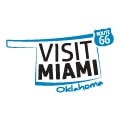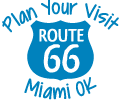It's Fishing Time in Miami, Oklahoma... The Caviar Capital of Oklahoma!
As you consider a destination for a spring getaway, get your fishing gear ready and head to Northeast Oklahoma!
Paddlefish angling by all methods is closed on the Spring River from the State Highway 60 bridge upstream to the Kansas line. Snagging of paddlefish or any fish is closed from 10 p.m. to 6 a.m. year-round east of I-35 and north of I-40, except the Miami City Park from the south boat ramp to the 125 Highway bridge which shall remain open.
Residents and nonresidents may have one paddlefish in their possession in the field. Nonresidents may possess no more than the annual harvest limit at any other time.
Catch and release of paddlefish by use of rod and reel, trotlines and throwlines is allowed, year-round. Paddlefish must be released immediately after being caught, unless kept for the daily limit. Anglers fishing trotlines or throwlines must release all paddlefish before leaving their lines (unless keeping one for a daily limit).
Paddlefish taken by bowfishing, gigs, spears and spearguns cannot be released.
Each cleaned paddlefish and its parts (carcass, meat or eggs) must be tagged and kept separate from all other cleaned paddlefish or paddlefish parts. Each person must keep their paddlefish distinctly separate from paddlefish taken by others. Paddlefish and paddlefish parts must remain tagged until the person in possession of the same reaches their residence.
No person can possess eggs (attached to the egg membrane) of more than one paddlefish. No person can possess more than 3 pounds of processed paddlefish eggs or fresh paddlefish eggs removed from the membrane. Processed eggs are any eggs taken from a paddlefish that have gone through a process that turns the eggs into caviar or into a caviar-like product.
No person can ship into or out of, transport into or out of, have in possession with the intent to so transport, or cause to be removed from this state, raw unprocessed, processed or frozen paddlefish eggs.
All paddlefish must have all internal organs removed before leaving the state.
Note: For information on fishing below dams for paddlefish, see Tailwaters in the “Public Fishing Waters” special regulations. Snagging is closed for one mile below Eufaula Dam.
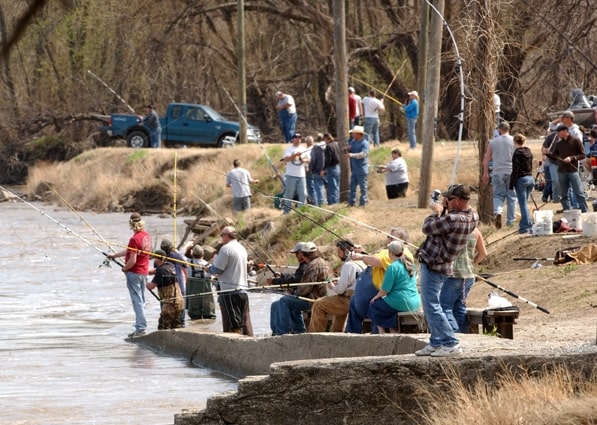
The cleaning station is set up a few months north of Twin Bridges State Park on Hwy 137. Anglers that are fishing at Riverview Park in Miami can call the center to come pick up their paddlefish for processing. Those who take advantage of this service will take home meat from their own fish that has been safely cleaned and packaged.
Heading to Miami, Oklahoma? Here is some helpful spoonbill fishing information!
Anglers line up “elbow to elbow” every season along the banks of the Neosho River for a chance to snag this prehistoric prize called Paddlefish (or Spoonbill by the locals). During their early spring spawning run, Spoonbill can be caught by snagging with a stout surf rode, heavy test line and a large barbless treble hook.
Important Paddlefish Regulations
- Barbless Hooks ONLY
- One (1) rod and reel (pole and line) per angler.
- Daily Limit: One (1) fish.
- Annual Limit: Two (2) fish.
- Residents and nonresidents, regardless of age or exemption status, must obtain a free paddlefish permit, annually (permits expire on Dec. 31); permit must be carried on person (electronic or hardcopy).
- Fish kept must be tagged immediately with angler’s customer ID number.
- Once a fish is kept, it CANNOT be released (no culling).
- Once a fish is kept, angler MUST stop fishing (snagging) for the day.
- Snagging prohibited from 10 p.m. to 6 a.m. east of I-35 and north of I-40, except the Miami City Park.
- MUST E-Check all harvested fish within 24 hours (E-Check at gooutdoorsoklahoma.com)
Fishing License:
Wal-Mart Sporting Goods Department- 918-542-6654
- Open 24 Hours
- $25-- Resident Fishing License (Oklahoma Residents)
- $35 (6 Day License for Out-Of-State)
- $55 for Out-Of-State Year-Round
- Paddlefish permits available for free-- required for all ages (bring proof of social security number for those under 16)
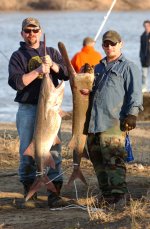
Paddlefish Tackle:
Remember paddlefish are large so you have to think BIG when selecting your tackle. Below is a list suggested tackle you should have in order to increase success.
- 10 to 12 ft. Heavy action Rod
- Large capacity reel
- 50 lb. test line
- 10/0 to 12/0 treble hook
- 5 oz. to 1 lb. of weight (Depending on if you are trolling or bank fishing).
Paddlefish Research Center
Location: 61091 E. 120 Road, Miami, OK 74354. (Four miles north of Twin Bridges State Park.)
Hours: 9am-6pm Thursday through Monday (closed Tuesday and Wednesday). Opening March 1 and closing April 30.
Contacts: Call Paddlefish/Caviar Coordinator at (918) 686-3673 or the Paddlefish Research Center at (918) 542-9422.
Fish pick-up: Wildlife Department personnel will pick up live paddlefish from bank and boat anglers at Grand Lake. Call the PRC to arrange for a pick-up.
Purpose: Wildlife Department biologists collect important biological data for paddlefish management, process paddlefish meat for anglers and salvage paddlefish eggs. The PRC also serves as the hub for statewide paddlefish management and research activities.
How to Snag a Paddlefish
There are two ways to hook a paddlefish — manpower and boat power. The one thing you won’t need is a lure of any kind. Paddlefish feed on microscopic plankton and will not bite lure; instead they are caught by dragging a hook and a weight through the water until you snag a paddlefish.
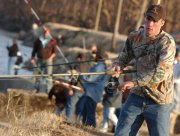
Many anglers, especially when fishing the moving water of rivers, prefer to cast out and reel the hook back in. The key to this technique is making long sweeps with your rod away from your hook and then reel the slack line up as you point your rod tip back towards your hook. Herky jerky action will only make you tired and sore. The more time your hook is moving through the water, the better chance you have of hooking a fish.
Other anglers, especially early in the season in the upper end of lakes, find the most success by trolling. If you see boat dragging back and forth or in lazy circles in the spring, there is a good chance they are dragging a line, hook and weight behind the boat. Anglers that use this method watch for their rod tip to thump, grab the rod and reel and then hang on to fight the fish.
If you are new to paddlefishing, don’t be afraid to ask questions of your fellow anglers on the water or at the bait shop. Most anglers are more than happy to pass on a few tips.
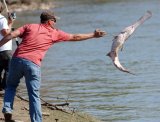
Frequently asked questions:
Why can I only keep two fish?
After years of data collection and consideration of numerous alternatives, Wildlife Department biologists have concluded that an individual annual harvest limit is the best solution for long-term harvest management in Oklahoma. The primary goals are to conserve the resource and reduce total harvest while preserving opportunity for as many anglers as possible. Catch-and-release angling for paddlefish remains available statewide, year-round with few restrictions.
I have a permit, so what do I need to do to harvest a fish?
Once an angler catches and decides to keep a fish, the fish should be labeled with the angler’s customer ID number. One option is to put duct tape around the bill and write the angler’s customer ID number in permanent marker. Within 24 hours of harvest, the paddlefish must be reported. Go to wildlifedepartment.com or visit the Paddlefish Research Center during business hours to report your harvest. Once reported, the angler will receive a confirmation number. Retain the number for your records.
Why is it prohibited to snag for paddlefish with more than one rod and reel?
In recent years, snagging for paddlefish has transitioned from primarily a bank fishery to a boat fishery due to improvements in sonar technology, access, and information on staging areas. Groups of paddlefish staging to spawn are highly vulnerable to boats with multiple rods per angler, and this scenario provides for higher incidence of take violations, additional fish stress, and gives boating anglers a distinct advantage over bank anglers.
What do I do if I catch a banded paddlefish?
If you harvested the fish, there will be an opportunity to report the band during the E-Check process at wildlifedepartment.com. If you released the fish, please report your band at PaddlefishBands.com or call the Paddlefish Research Center at (918) 542-9422.
If you are bringing a group to Miami for spoonbill, please register at the Miami Convention and Visitors Bureau. Special rates and discount coupons are available to groups that are staying over night in Miami. Please refer to our Miami Hotel list of CVB partner hotels. Watch the Visit Miami OK Facebook page for special giveaways for spoonbill/paddlefish groups! @visitmiamiok
Miami Convention and Visitors Bureau | 918-542-4435 | www.visitmiamiok.com
Spoonbill Wreckers – Promotional Partner: Four hour spoonbill fishing trips are available with all gear included. Book your group by contacting Bryan at 918-533-3825. Mention you saw their information on the Visit Miami OK website for special pricing on Miami area hotels.
